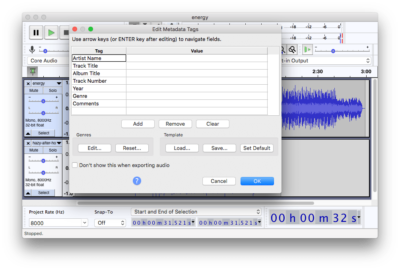
You can select ‘No’, to not locate them manually and continue using the application with a larger array of file types.

Use the following links to download the FFmpeg Library and install it:.It is recommended that you exit Audacity before installing FFmpeg. Instead, use the following instructions to download and install the free and recommended FFmpeg third-party library. Because of software patents, Audacity cannot include the FFmpeg software or distribute it from its own websites. Do not download Audacity from other sources.The optional FFmpeg library allows Audacity to import and export a much larger range of audio formats including M4A (AAC), AC3, AMR (narrow band) and WMA and also to import audio from most video files. NOTE: Only use links to download provided by the Audacity Manual. To download Audacity on your personal computer, follow these instructions: It is also available on the Laptop Cart (Set of 30). In addition to the Audio Rooms, Audacity is available on the student and faculty laptops, quick access computers, in the Computer Commons, 2nd floor Library computers, group rooms, presentation practice rooms, Data Hub, and Library Classrooms. The Programming Historian Audacity Tutorial MRU Library Tutorial: Introduction to Audacity: Editing and Recording To open mp4 files (vidoe) in Audacity, the FFmpeg encoder must be installed.Audacity cannot export files to mp3 file type without the installation of the LAME mp3 encoder.Audacity is multitrack software, but is not recommended for multitrack recording.For this reason, save extra original copies of your audio files or recordings before you start editing. Once you save your edits, they cannot be undone.

Audacity is a destructive editor - edits to audio files are made directly to the file.Software is free and available for use on personal computers. Operates on both Mac and Windows computers.Audacity is a versatile free and open-source audio editor and recording software that is easy for beginners.


 0 kommentar(er)
0 kommentar(er)
